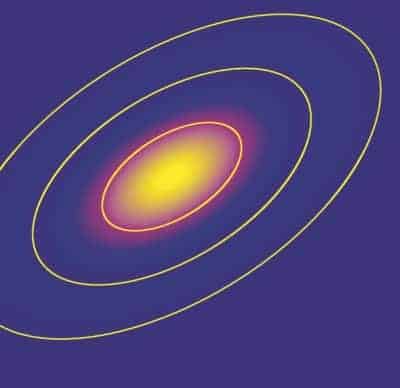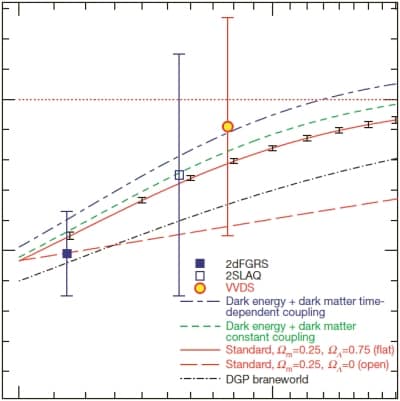
This time ten years ago, two independent teams of researchers in the US were deliberating over whether to go public with a discovery that would change our view of the universe forever. It concerned observations of distant supernovae that appeared to be moving away from each other faster than they should have been. A few weeks later the world found out that the expansion of the universe is accelerating, probably driven by some kind of gravitationally repulsive “dark energy” that makes up 75% of the universe.
Fast-forward a decade and physicists still have no idea what dark energy is. It may not even exist at all: the cosmic acceleration could instead signal that it is time to replace Einstein’s general theory of relativity with a new theory of gravity. Astronomers in Europe have now shown that small changes in the distribution of galaxies over time could help settle this issue, as well as constrain competing models of dark energy itself. It’s a small, but relatively simple, step towards solving a mammoth problem.
Galactic red-shifts
This opens up a new window on dark energy, and right now we can use all the views we can get! Eric Linder, University of California at Berkeley and Berkeley Lab
Researchers get a handle on cosmic dynamics by studying the rate at which galaxies fly apart, which comes down to measuring how much their light has been “red-shifted” to longer wavelengths. When Edwin Hubble showed in 1929 that the red-shift of distant galaxies is proportional to their distance from Earth, it proved that the universe was expanding. The same principle underpinned the 1998 discovery that the expansion is accelerating, only this time the measurements involved “standard candles” called Type-1a supernovae.
But these cosmic red-shifts are distorted by the motion of galaxies themselves, for example due to the gravitational attraction of nearby objects. The amount of distortion therefore provides a measure of how quickly structure formed at a certain time, which in turn depends on the energy content of the universe and also on whether general relativity is correct. Measuring galaxy distortions is not new in itself, but by doing so at different cosmic epochs researchers may be able to learn more about the cosmic acceleration. “A discrepancy between the amount of distortion at different times would be a smoking gun for a new theory of gravity,” says Luigi Guzzo of the Brera Astronomical Observatory in Italy.
Using the Very Large Telescope in Chile, Guzzo and his 50-strong international team measured 13,000 spectra from galaxies that existed 7 billion years ago (Nature 451 541). The researchers then compared the amount of distortion present in these spectra with a separate survey of the local (that is, recent) universe in the same region of sky. The two measurements only agreed if the team invoked an unknown extra energy ingredient in the vacuum in line with the “cosmological constant”. This constant, which Einstein added to his equations in 1917 (and later withdrew) to make his theory fit with the then observation that the universe was static, is the simplest current explanation for dark energy.
However, the sample of galaxies studied so far is not large enough to distinguish a physical dark energy from alternative extended gravity theories, which include extra-dimensional “braneworld scenarios” as well as modifications to general relativity. “The error bars are too large to tell us anything new about dark energy yet,” says Robert Caldwell of Dartmouth College in the US.
Extensive surveys
Guzzo is currently trying to convince the European Organisation for Astronomical Research (ESO) to start a new survey of some 100,000 spectra at the same cosmic epoch, which would allow the team to start discriminating between some dark-energy models. “Our most ambitious plan, which was recently put to the European Space Agency, is an infrared satellite called SPACE that will perform a survey of more than 100 million galaxies over the whole sky,” he adds.
Dark energy is so weird that no single technique is capable of elucidating its origin, and a host of other approaches — which include further supernovae surveys, measurements of the cosmic microwave background and gravitational lensing studies — will be put to work in the next few years. In particular, having such complementary techniques will help researchers disentangle the effects of dark energy from those due to matter, which itself is mostly made up of an unknown type of non-luminous or “dark” matter.
“It is still early days for the galaxy red-shift distortion technique,” says Eric Linder at the University of California at Berkeley and Lawrence Berkeley National Laboratory, who points out that a similar analysis of an earlier cosmic epoch is currently being undertaken by the DEEP2 survey in the US. “But this work opens up a new window on the mystery of dark energy, and right now we can use all the views we can get!”




